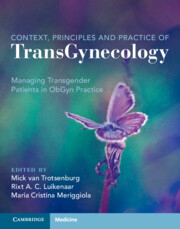Book contents
- Context, Principles, and Practice of Transgynecology
- Context, Principles, and Practice of Transgynecology
- Copyright page
- Dedication
- Contents
- Foreword
- Preface
- Contributors
- Abbreviations
- Section A Contextual Transgynecology
- Section B Practicing Transgynecology
- Section C Gynecological Surgery for Transgender Males
- Section D Sexuality and Contraception
- Section E Fertility and Reproduction
- Section F Impact of Gender-affirming Hormonal Therapy on Genital Organs
- Chapter 31 Changes to the Uterus from Supraphysiological Androgens
- Chapter 32 The Ovaries under Supraphysiological Androgen Exposure
- Chapter 33 The Vaginal and Neovaginal Microbiome under Androgen or Estrogen Exposure Respectively
- Section G Screening and Prophylaxis
- Transgynecology Index
- References
Chapter 32 - The Ovaries under Supraphysiological Androgen Exposure
from Section F - Impact of Gender-affirming Hormonal Therapy on Genital Organs
Published online by Cambridge University Press: 22 December 2022
- Context, Principles, and Practice of Transgynecology
- Context, Principles, and Practice of Transgynecology
- Copyright page
- Dedication
- Contents
- Foreword
- Preface
- Contributors
- Abbreviations
- Section A Contextual Transgynecology
- Section B Practicing Transgynecology
- Section C Gynecological Surgery for Transgender Males
- Section D Sexuality and Contraception
- Section E Fertility and Reproduction
- Section F Impact of Gender-affirming Hormonal Therapy on Genital Organs
- Chapter 31 Changes to the Uterus from Supraphysiological Androgens
- Chapter 32 The Ovaries under Supraphysiological Androgen Exposure
- Chapter 33 The Vaginal and Neovaginal Microbiome under Androgen or Estrogen Exposure Respectively
- Section G Screening and Prophylaxis
- Transgynecology Index
- References
Summary
Ovaries are the reproductive organs of women, producing the gametes and sex hormones.
The production of sex hormones is important for the regulation of ovarian function and menstrual cyclicity. Trans men undergo testosterone treatment or/and gender re-affirming surgery in order to overcome gender dysphoria. This treatment might result in the cessation of the normal ovarian function. For trans men that wish to retain their fertility options, ovarian function remains a prerequisite for genetically related offspring. Fertility treatments for trans men may occur before or in between testosterone treatment. Treatments following testosterone supplementation may have an effect in the proper ovarian function. This chapter deals in detail with the effects of testosterone on the ovarian anatomy and physiology.
- Type
- Chapter
- Information
- Context, Principles and Practice of TransGynecologyManaging Transgender Patients in ObGyn Practice, pp. 236 - 242Publisher: Cambridge University PressPrint publication year: 2022



